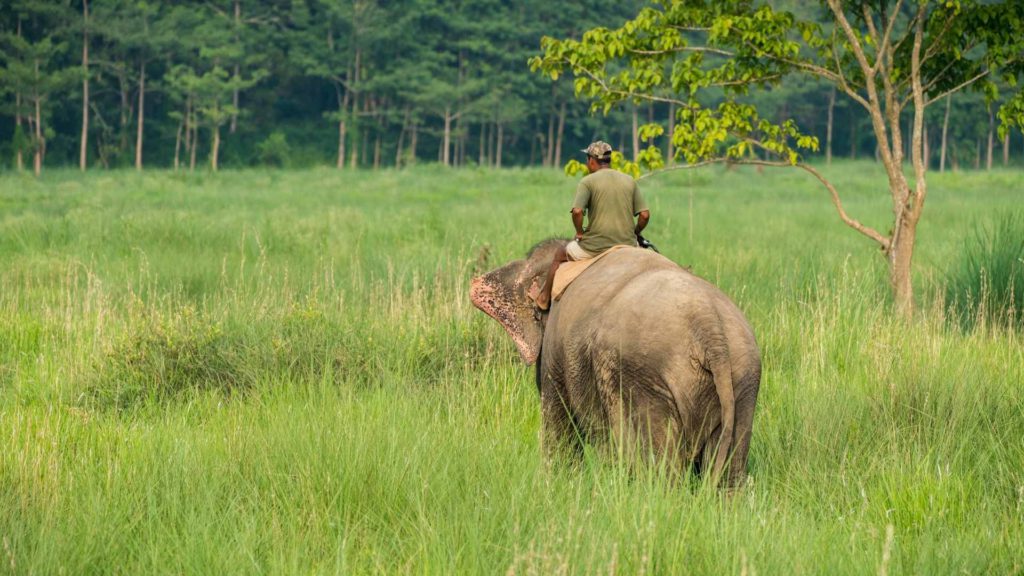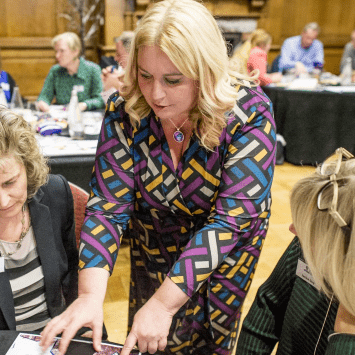Posted in Blog, Facilitation, Lead, Virtual Facilitation by Jo North
The elephant and the rider – how humans make decisions
The elephant and the rider is a great metaphor for facilitators to take on board.
There comes a point in every innovation sprint, meeting or workshop when the group needs to choose between a number of potential options.
If you lead meetings or facilitate workshops, it’s really helpful to understand how people make decisions. There will always be a degree of subjectivity in decision-making. However, using facilitation techniques and activities designed to enhance objectivity will support your workshop delegates in making more effective choices as a group.
This is because, as science shows, we make decisions based on our emotions and intuition 95% of the time. We justify those decisions afterwards to ourselves and others with logic.
Think about a recent purchase you made. The chances are that how you wanted to feel played a key part in your decision. For example, you might have told yourself that you needed a new outfit – and maybe you did need one. But it’s also likely that you wanted to buy something new to help you feel good. More confident, perhaps, for a night out? More safe for an adventure sport activity? (Depending on what you bought, of course). The wanting it is emotions at work. Telling ourselves we need it is our rational brain justifying our decision.
The elephant and rider metaphor illustrates this brilliantly.
The elephant and the rider metaphor
The metaphor of the elephant and the rider is used by social psychologist Jonathan Haidt in his books The Happiness Hypothesis and The Righteous Mind to represent how humans think.
The elephant portrays uncontrolled, intuitive and emotional thought processes. The rider represents more logical, controlled and analytical thinking. You might have come across similar distinctions between different ways of thinking if you’ve read or heard of The Chimp Paradox by Steve Peters, Hare Brain, Tortoise Mind by Guy Claxton, or Thinking, Fast and Slow by Nobel Prize winner Daniel Kahneman.
To continue with the elephant and rider analogy, the elephant – or emotional brain – is much bigger and more powerful than the rider – or rational brain.
The rider cannot control the elephant. When it’s feeling calm and centred, the elephant knows what’s good for us, and takes us in the right direction. The rider simply needs to gently guide the elephant, with a light touch.
But when the elephant is feeling emotional – upset, frightened, stressed or annoyed – it charges, or stubbornly refuses to budge. The rider has a much more difficult job of getting the elephant to go where it needs to.
Ideally, the elephant stays calm and focused on what’s important, and the rider works out the best route to take to arrive at the destination.
Decision-making in innovation sprints and workshops
The elephant and the rider metaphor can help facilitators in a number of ways.
Ideally, the rider assesses and plans the best route for where the elephant intuitively knows it needs and wants to go. The facilitation tools and activities that you choose ideally will support both the elephant and the driver in doing their best work – combining insightful intuition with logical, rational choices.
The metaphor’s a good reminder that the facilitation techniques and activities we choose for the decision-making phases of a meeting or event need to allow space and opportunity for people in the group to let their intuition do its best work.
Make sure intuition isn’t crowded out by too many rigid, analytical tools. Ensure too that the environment you create is conducive to allowing people to be calm, focused and balanced. Be mindful of group dynamics. Build psychological safety in your sessions. We don’t want the elephant to charge, or refuse to budge!
On the other hand, intuition and emotion on their own are not enough. Some logic and rational thinking are needed for more objective assessment of options, and for planning.
The elephant and rider need to be in balance, and work together as a great team.
The emotional brain and resistance to change
It is the emotional brain that resists change. We explain our resistance by giving logical reasons for it.
If you observe that the group you’re facilitating is reluctant to change something, or try new things, it could well be worth exploring what feelings are driving their resistance.
Opening up ways to help your group find and tap into motivational, positive aspects of change will support them in moving forward.
Map the shortest route possible
To keep the elephant on course and help the rider do its job, design a workshop process that takes your delegates on the shortest route possible – without skimping though! – to achieve your session objectives. Make it as easy, enjoyable and productive an experience as you can.
Check in with your own elephant and rider
Perhaps most important of all, to be a great facilitator, keep checking in with yourself as you’re facilitating. Look after your own elephant and rider. You’ll enjoy your facilitation practice so much more, your balanced energy will transfer to your delegates and the whole workshop experience will benefit as a result.

Additional Insights: Using the Elephant and Rider for Better Decision Making in Workshops
The elephant and the rider – it’s more than just an interesting mental image. It’s a metaphor of the elephant and rider that offers powerful tools for understanding human behavior and guiding groups towards effective change.
The Elephant, The Rider, and Human Behavior
Derived from the insights of NYU psychologist Jonathan Haidt, the elephant analogy reflects the duality in our human mind. Imagine a six-ton elephant and its rider. The elephant represents our emotional side – vast, powerful, and often driven by instinct. In comparison, the rider, perched on the back of the elephant, symbolizes our rational mind – analytical, planning, but small relative to the enormous elephant.
Chip Heath and his brother Dan Heath, who are associated with Stanford University and Duke University’s Centre, respectively, expanded on this concept in their book “Switch“. The Heath brothers detail the challenges of making behavior change stick. They stress the rider’s control isn’t absolute. When the elephant’s emotional side gets stirred, it can overpower the rational rider. The key point here? For meaningful change, both the elephant and the rider must align.
Bright Spots and the Path Forward
Instead of focusing on problems, the Heath brothers emphasize identifying “bright spots”, those successful efforts worth emulating. For example, imagine a workshop where team members highlight the last time they felt most productive. Such positive instances can illuminate the path of least resistance and establish a clear goal for the team.
Overcoming the Challenges
The rider-elephant framework is not just ancient wisdom; it’s a modern truth backed by behavioral economics and neuroscience. The rational rider may set the destination, but without the elephant’s buy-in, the journey becomes arduous. A significant role in this buy-in process is played by the surrounding environment. Often, people’s rational side is thwarted by a lack of clarity.
Change efforts often fail due to this lack of clarity. “Critical moves” are important– clear, actionable steps, not vague ambitions. Awareness of the “fundamental attribution error” in human nature shows we often blame people, but not the situation. Therefore, adjusting the surrounding environment can create a more conducive path for the elephant.
Insights from the Field
A great example comes from the world of customer satisfaction. Instead of just relying on managers to improve customer relations, some businesses survey customers directly, allowing the feedback to shape the bigger picture. By doing this, staff feel empowered and are more inclined to align with positive changes, as they have a tangible sense of the desired outcome.
Moreover, insights into the sides of our brain – the conscious processing parts, like the limbic system governing stress response, and the emotional level – suggest that both rational and emotional minds need support for behavior change. Peer support groups, exercise programs, and even the advancement of social entrepreneurship serve as testaments to this concept.
Guiding the Elephant and Rider in Workshops
To effectively guide groups in a workshop, facilitators must address both sides of their participants’ brains. The hardest part often isn’t setting the end goal but guiding the journey towards the finish line. With the right tools, a sense of identity, great leadership and a growth mindset, there’s a very good chance of achieving that.
The Power of Unity
The metaphor of the elephant and the rider teaches us an important lesson: addressing both the emotional mind and the rational mind is the best way to effect change. By understanding this dynamic, as a facilitator you can better prepare for workshops, ensuring your team not only understands the end goal but is emotionally invested in reaching it. As a result, the chances of long-term, meaningful change increase manifold.


